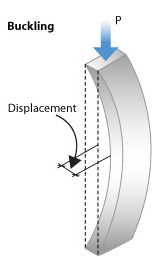Radius of gyration (r)

This is another property of a section and is also a function of the second moment of area. Put in general terms, the radius of gyration can be considered to be an indication of the stiffness of a section based on the shape of the cross-section when used as a compression member (for example a column).
The diagram indicates that this member will bend in the thinnest plane.
The radius of gyration is used to compare how various structural shapes will behave under compression along an axis. It is used to predict buckling in a compression member or beam.
The formula for the radius of gyration r is:
where I = second moment of area
A = area of material in the cross section
Note: The unit of measurement for the radius of gyration is mm.
The smallest value of the radius of gyration is used for structural calculations as this is the plane in which the member is most likely to buckle. Square or circular shapes are ideal choices for columns as there is no smallest radius of gyration. They have the same value because the radius is constant.
